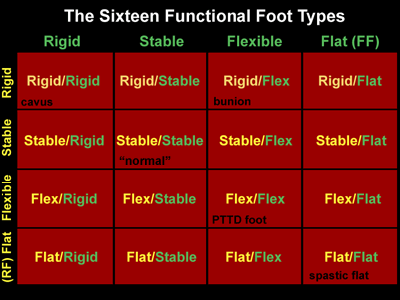Profiling the Pedal Snowflakes
|
If no two feet are alike, then why should subtalar joint neutral casting technique, a three degree rearfoot varus post and a three degree forefoot varus post be the default for 80% of thecustom foot orthotics dispensed in the U.S.A.?
Research and the literature suggest Root Neutral casting to be less than optimal (1). They point out reasons to acculturate to a new standard that has loftier goals for care and predictable improved outcomes for more feet.
A foot typing system such as Scherer’s (2) when expanded, may allow practitioners to offer beneficial foot type-specific therapeutic casting and prescription options that would otherwise harm other feet. The goals of biomechanical care could be elevated from comfort and pain relief to prevention, performance enhancement and improved quality of life for our patients expanding the current paradigm for non-surgical podiatry care.

|
I propose a new Centering Theory of Biomechanics that applies the principles and terminology of architectural engineering to the structure and engineering of the foot. If we replace Root’s misconception that foot and postural pathology is largely due to excess subtalar joint pronation (rearfoot collapse), with the premise that some feet collapse in the rearfoot, some in the midfoot vault, some in the forefoot and yet others in more than one place, a profiling system that accurately predicts the locations of progressive weakness and deformity for each foot would allow for targeted kinetic and kinematic treatment that could provide renewed strength and support biomechanically, beyond treating symptoms.
 |
RF Serm |
One such profiling system known as Functional Foot Typing® (3) measures two rearfoot and two forefoot open chain positions that predict the functional capability of the foot at important moments in closed chain gait.
From Root Neutral Position, the Rearfoot Supinatory End Range of Motion (Rearfoot SERM) is either inverted or less often everted for all feet. The Rearfoot Pronatory End Range of Motion (Rearfoot PERM) is inverted or less often vertical or everted for all feet. RF SERM predicts the position of the STJ at heel contact and RF PERM predicts the compensatory position of the STJ just before midstance.
 |
FF Serm |
From Root Neutral Position, the Forefoot Supinatory End Range of Motion (Forefoot SERM), the
first ray is either plantarflexed or less often dorsiflexed for all feet. The Forefoot Pronatory
End Range of Motion (Forefoot PERM) is either plantarflexed, level or more often dorsiflexed for all feet. The FF SERM predicts the first ray position at early midstance and the FF PERM predicts the compensatory first ray position in late midstance.
Once tested, every rearfoot can be classified rigid, stable, flexible or flat and every forefoot can be classified rigid, stable, flexible or flat. There are 16 possible Functional Foot Types (FFT’s) but 90% of all feet classify into one of five common FFT’s, the Rigid/Rigid (cavus), The Rigid/Flexible (bunion, ballet foot), the Stable/Stable (“normal”), the Flexible/Flexible (PTTD) and the Flat/Flat (spastic flatfoot) (see Table 1 below). Foot type-specific rules for casting and prescribing become the starting point for orthotic fabrication. The skilled practitioner can then further customize casting, posting, materials and forefoot modifications case by case, producing a snowflake orthotic addressing the needs of each pedal snowflake.
Negative casting corrections that support the rearfoot, raise the vault and/or lower the first ray produce foot orthotic shells that are for most patients shorter, narrower and higher arched than current custom and OTC devices.
Table 1 |
 |
When combined with a patient specific prescription (i.e. the rigid rearfoot types favor a varus rearfoot post, the stable and flexible rearfoot types do best with a vertical rearfoot post and the flat rearfoot types need a valgus rearfoot post and the DPM Rx’s #’s of degrees case by case), this system provides renewed mechanical advantage to poorly leveraged muscles like posterior tibial, peroneus longus, flexor hallucis longus and the “core intrinsics”. These muscles, when "centered" in their custom Foot Centring, accept training, harnessing new power for stability and function that goes beyond eliminating pain.
In summary, Functional Foot Typing allows classification of all feet into specific types, that when further modified case by case, produce a new paradigm for practicing non surgical and postop podiatry (4).
References:
- Kirby KA, Are Root Biomechanics Dying? Podiatry Today: Volume 31; April 4, 2009; p. 32-39
- Scherer PR, Morris JL, The Classification of Human Foot Types, Abnormal Foot Function and Pathology: Valmassy RL, Chapter 8; Clinical Biomechanics of the Lower Extremities, St. Louis: Mosby; 1996. p. 85-93
- Shavelson DE, A Closer Look at Neoteric Biomechanics; Podiatry Today: Volume 20; Sept 1, 2007; p.28-35
- Shavelson, DE, Neoteric Biomechanics; Podiatry Management: September 2008; p. 122-126
|
Next Issue: The Common Functional Foot Types
GRAND SPONSOR |
|
MAJOR SPONSORS |
|
|
|
|
|
|
|
|
|
|
|
|
|
|
|
|
|
|
|
|
|
|
|
|
|
|
|
|
|
|
|
|
|
|
|
|
|
|
|
|